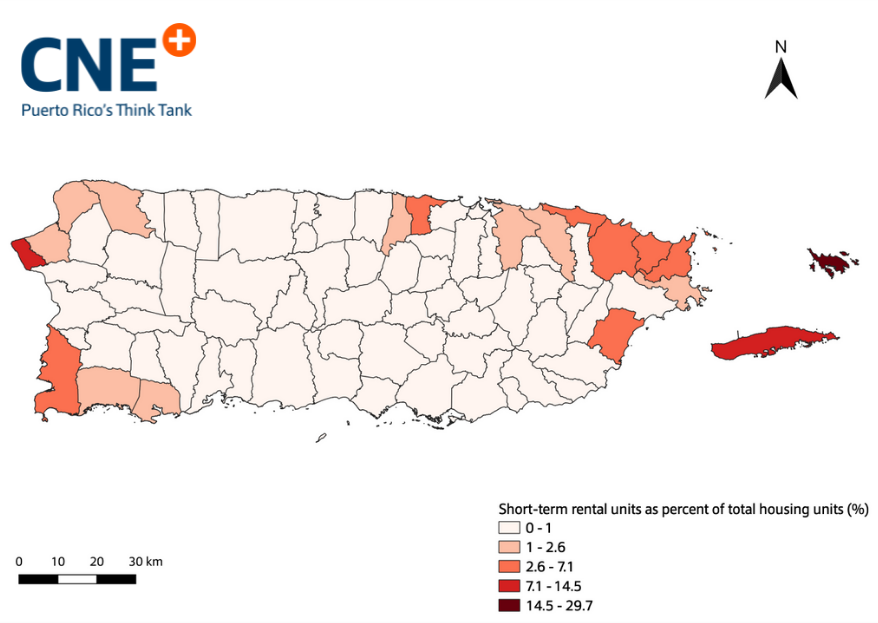Puerto Rico’s Housing Situation Five Years After Hurricane María
Published on June 29, 2022 / Leer en español
The combined impacts of hurricanes Irma and María exacted a disastrous toll on Puerto Rico’s housing sector. Over 725,000 households reported damages to their dwellings, representing close to 60% of occupied housing units on the island. These storm damages came on top of a range of housing problems that have been developing over the course of many years. Land tenure and titling issues are common, partly due to the fact that Puerto Rico has consistently failed to produce sufficient affordable housing units for a large portion of the population. Increased production in certain segments and underproduction of social housing, over time, has led to a large number of vacant housing units, a growing affordability crisis, and very long waiting lists for public housing and Section 8 vouchers. Moreover, the vast number of homes located in flood zones, lacking insurance and built without complying with building codes increased the vulnerability of hundreds of thousands of families prior to the hurricanes making landfall.
Unfortunately, five years after the 2017 storms made landfall, little progress has been made to address the island’s housing needs. In fact, the situation has gotten more precarious, especially for low-income families seeking affordable homes, given a 22% increase in housing prices from 2018 until 2021. In past years, there was a surplus of market-priced properties that no one bought, and a deficit of social and affordable housing that no one was supplying. Today, there is a surplus of properties being bought at prices above appraisal, and an even worse deficit of affordable and social housing that nobody is supplying.
Since 2018, CNE’s Blueprint Initiative has provided a platform for productive conversations and knowledge exchanges on issues of land ownership, accessibility, and safe housing. Given our dire housing situation, our primary objective is to bring together existing efforts and strategic thought partners to devise a collective roadmap for the reconstruction and beyond. To achieve this, we have been conducting research on a range of post-disaster housing topics, developing interactive tools, and organizing events for the wider public.
Below is a brief review of the ongoing and completed research we have been working on for the past years.
1. Who Gets Emergency Housing Relief? An Analysis of FEMA Individual Assistance Data After Hurricane María
In the months after Hurricane María’s devastation of Puerto Rico, press outlets and advocacy groups documented how Puerto Rico’s experience with housing repair and reconstruction programs was rife with complaints and inconsistencies regarding approval of applications and denial of support, especially among vulnerable communities. CNE produced a research paper, published in Housing Policy Debate, that contributes to the critical task of revealing post-disaster damages and reconstruction trends through a detailed examination of housing and personal property damages and benefits received through the Federal Emergency Management Agency (FEMA)’s Individual Assistance (IA) Program after Hurricane María. We also examined if housing needs were equitably addressed by placing attention on whether poor households, or those located in very vulnerable communities with inadequate infrastructure and precarious socioeconomic conditions, known locally as Special Communities, were unfavorably served.

Heatmap of total household damage, as estimated by FEMA’s Individual Assistance program. Source: FEMA & Puerto Rico Planning Board.
Overall, poor households and those living in Special Communities were not likely to be excluded from receiving emergency aid. In fact, they were more likely to have been inspected and receive monetary assistance. But CNE did find that land tenure status matters, and is a major factor to determine the likelihood that an applicant household can access FEMA funds. Applicants with what FEMA terms “unknown tenure” fare worse off than homeowners.
Particularly notable was the relationship between poverty and “pending housing need”—which is the difference between the FEMA damage estimates and the FEMA award given to an applicant—. Interestingly, households under the federal poverty line had higher pending housing needs compared to non-poor households. This is particularly worrisome because poor households are less likely to receive other forms of aid in the immediate period following a disaster, like SBA loans, and are thus left in a temporal limbo and susceptible to displacement, until other major reconstruction programs come on line.
2. Tracking Neighborhood Change in Geographies of Opportunity: A Case Study of San Juan, Puerto Rico
Previous studies on disasters and long-term housing reconstruction in the United States show that the recovery process of neighborhoods evolves in a highly unequal manner within cities. Research conducted in Miami, Galveston, and New Orleans demonstrates that natural disasters are followed by high rates of housing market volatility, property abandonment, and gentrification waves. Considering that disasters can affect housing markets and lead to neighborhood change, with this research project, CNE identified whether these kinds of local-level transformations were observed in the San Juan Metropolitan Area (SJMA) following Hurricane María. Our analysis centered on neighborhood changes, their relationship with storm impacts, and the spatial distribution of opportunities—namely, access to jobs, education, and safety.
Our results, published in the Lincoln Institute for Land Policy working paper series, show that:
(1) Pending housing needs were more acute in neighborhoods with increased poverty concentration, furthering socioeconomic segregation in post-disaster SJMA.
(2) Storm impacts are also associated with higher housing prices and sales in certain areas. Rent increases were also observed in neighborhoods with a higher percentage of damaged units.
(3) Similarly, some neighborhoods also experienced increased vacancy rates as a result of storm damages. This finding demonstrates that the impact of storm damages on neighborhoods varies. While some neighborhoods experience gentrification pressures, others have experienced increased decline.
We also created an opportunity score that ranks neighborhoods in the SJMA given their access to jobs, education, and safety, and tested the relationship between the score and measures of neighborhood change. This exercise revealed that access to opportunities is closely related to increases in housing prices, socioeconomic segregation, and vacancy rates. These research findings have numerous policy implications for the post-disaster reconstruction process. For example, given that housing in high-opportunity areas is increasingly less tenable for low-income households, the government of Puerto Rico should prioritize locating affordable units, financed with federal recovery dollars, in these areas. At the same time, low-opportunity areas should be given priority for infrastructure improvements, community lifelines, hazard mitigation, workforce development, and local business aid spending programs.
 Median unit price between 2016 and 2019 for the San Juan Metropolitan Area at Census tract level.
Median unit price between 2016 and 2019 for the San Juan Metropolitan Area at Census tract level.
Source: Puerto Rico Community Survey and Luis Abreu & Associates
3. Upcoming Project: Housing, Disasters and Displacement
Building on the research conducted on FEMA’s Individual Assistance Program, CNE is currently working on a project—in collaboration with Elora Lee Raymond from Georgia Tech’s School of City and Regional Planning—that examines the relationship between post-disaster reconstruction efforts and migration patterns in Puerto Rico. Academic inquiries regarding population movements following Hurricane María have yielded estimates that range from over 400,000 persons leaving the island, to just over 120,000 individuals moving out in the year following the catastrophic event. While these studies paint a broad-brush picture of movement and population loss, they do not provide a detailed understanding of the migration push factors, including those related to pre-storm vulnerabilities, storm exposure, damages, and federal response, at the community or neighborhood level. We tackle these issues through an in-depth analysis of three primary sources of data: the Federal Reserve Bank of New York/Equifax Consumer Credit Panel data, FEMA Individual Assistance applicant records, and the 5-year estimates from the Puerto Rico Community Survey.
Although we’re still fine-tuning our statistical models, we’ve found interesting patterns regarding post-disaster moves. To give you an idea of the overall trends, the overwhelming majority of people in our study sample did not move following hurricane María. However, of those who moved, most did so within their municipality. A smaller proportion moved within Puerto Rico but outside their municipality, and an even smaller percentage moved outside the island. This confirms the findings in the academic literature which suggests that most moves following a disaster are short distance. With regards to returns, the trends show that most of those who moved do not return to their community of origin after two years.
4. Upcoming Project: Short-Term Rentals in Puerto Rico
CNE’s most recent research project is an in-depth examination of the short-term rental market in Puerto Rico. Over the past five years or so, numerous press reports and community advocates have been highlighting how increases in rents and housing prices are contributing to gentrification pressures and the displacement of long-term residents, especially low- and moderate-income neighbors. Building on our work on “geographies of opportunity”, which demonstrated that Hurricane María was an inflection point that has led to significant changes in Puerto Rico’s housing markets, we are interested in gaining an in-depth understanding of how the rapid expansion of short-term property rentals (through platforms like Airbnb, Home Away, etc.) has contributed to distinct neighborhood changes in a growing number of communities. Our goal is to provide some general trends and patterns, from 2014 until before the global pandemic struck, and carefully assess how these kinds of real estate investments are contributing to gentrification and displacement pressures.
Some early results of our analysis show that for every 10% increase in the total number of units dedicated to short-term rentals in a neighborhood:
- Median rents increase by at least 5%
- Unit purchase price (in dollars per square foot) increases by 23%
- Sales volume in a neighborhood increases by 1%

Short term-rental units as percent of total housing units
Source: AirDNA and Puerto Rico Community Survey


